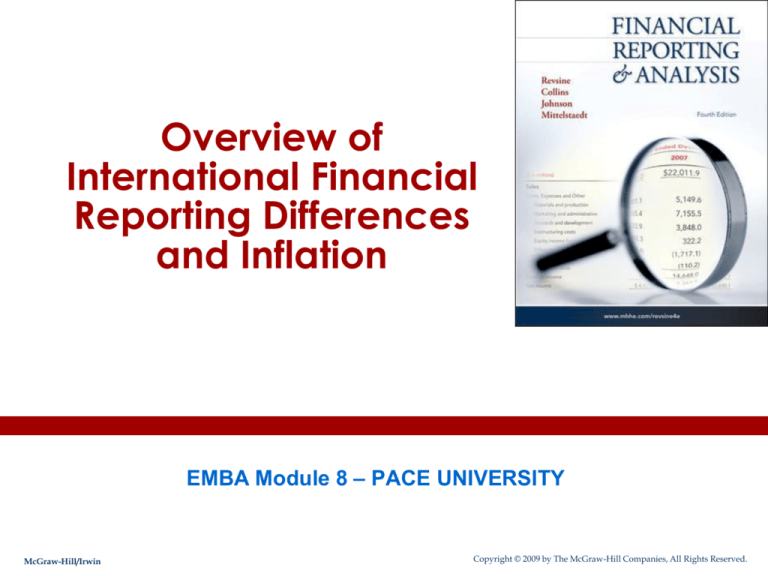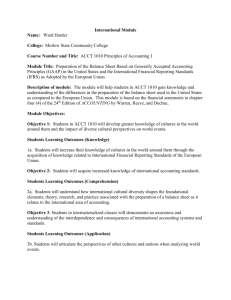
Overview of
International Financial
Reporting Differences
and Inflation
EMBA Module 8 – PACE UNIVERSITY
McGraw-Hill/Irwin
Copyright © 2009 by The McGraw-Hill Companies, All Rights Reserved.
Learning objectives
1. How globalization has relaxed cross-border barriers and
prompted convergence of reporting standards across countries.
2. Why the International Accounting Standards Board (IASB) has
become important.
3. What is IFRS?
4. How does IFRS differ from GAAP?
5. What is the impact of IFRS on technology companies?
6. U.S. Roadmap
7. Inflation Accounting
RCJM: Chapter 18
© 2009
2
Overview:
Growth in cross-border securities transactions
RCJM: Chapter 18
© 2009
3
Overview:
Why international accounting is important
U.S. companies do not dominate the global economy.
The growth in global investing has been fueled by:
Relaxed security market regulatory rules - easier for foreign firms to
meet listing requirements.
Improvements in telecommunications and computer technology investors access to information on a global scale.
Investors understand that global investment strategy portfolios may
be less risky than are those composed exclusively of domestic
companies.
RCJM: Chapter 18
© 2009
4
What is IFRS?
As indicated within the title, these standards are aimed at a global
practice.
IFRS stands for International Financial Reporting Standards.
The goal is to achieve a single set of high-quality, common
accounting standards used around the world.
These standards are the result of a convergence of international
viewpoints.
RCJM: Chapter 18
© 2009
5
International Financial Reporting:
The IASC and the IASB
International Accounting
Standards Committee
(IASC)
International Accounting
Standards Board
(IASB)
• Formed in 1973.
• Included professional accounting organizations in
10 countries – including the United States
• Establishes high quality, understandable and enforceable
global accounting standards.
• Works to achieve convergence throughout the world.
• Includes more than 130 countries.
• Has issued 41 International Financial Reporting
Standards (IFRS).
RCJM: Chapter 18
© 2009
6
International Financial Reporting:
U.S. GAAP vs. IFRS
Compared to U.S. GAAP, IASB standards allow firms more latitude.
IFRS often permit different accounting treatments for similar
economic events.
Benchmark
treatment
Allowed
treatment
Preferred
May be used
IFRS frequently follow a more “broad brush” approach than does
U.S. GAAP.
Existing differences between U.S. GAAP and IFRS will be narrowed
in the future.
RCJM: Chapter 18
© 2009
7
Is IFRS different than US GAAP?
There are differences between IFRS and US GAAP but more alike than
different for most commonly encountered transactions.
IFRS is largely grounded in the same principles as US GAAP.
Differences standard setters have had the advantage of:
Draw on the latest standard setters from around the world,
Taking a fresh approach and avoid perceived problems that might exist in US
GAAP, and
Annual improvement process, the standards are reviewed to enhance their
clarity and consistency.
RCJM: Chapter 18
© 2009
8
Is IFRS different than US GAAP?
IFRS standards are more broad and principles based with
limited interpretive guidance - leave implementation of the
principles embodied in the standards to preparers and auditors
and its interpretive body.
US GAAP contains underlying principles as well but is more
specific and rules based with far more comprehensive
implementation guidance and industry interpretations: US GAAP
is 25,000 pages and IFRS is 2,500 pages!
The following example is a simple illustration of principles- vs.
rules-based concepts:
RCJM: Chapter 18
© 2009
9
Is IFRS different than US GAAP?
Principles based:
Your parents tell you to do your best to get good grades and that
if you do not, they will consider the substance of your reasons.
Rules based:
Your parents tell you to get a 3.2 GPA or above and then provide
15 contingencies that might justify acceptance of lower grades.
RCJM: Chapter 18
© 2009
10
International Financial Reporting:
Some difference between U.S. GAAP and IFRS
Long-lived assets
Reversal of impairment
losses
Inventory valuation
Research &
development
Capitalized interest
RCJM: Chapter 18
U.S. GAAP
IFRS
Historical cost minus
depreciation and
impairment loss
Permits upward revaluation
when replacement cost is
above original cost
Prohibited
Permitted
Allows LIFO
Does not allow LIFO
Expensed as incurred
Separate rules for
“research” phase and
“development” phase
Requires capitalization in
certain instances
Benchmark treatment is to
expense all interest
© 2009
11
International Financial Reporting –
Technology Companies
Differences in reporting using IFRS in technology companies.
Under GAAP – R&D costs are generally expensed when incurred
– exemptions relate only to development of software for internal
use and website development costs.
Under IFRS – The development activity results in an intangiable
asset that gets capitalized and will get amortized based upon
tests for impairment.
Bottom line – Capitalization rate for R&D for software and internet
companies in Europe went from 0 to 61% for companies with R &
D expenditures ranging from $30M to $2.1B.
RCJM: Chapter 18
© 2009
12
International Financial Reporting –
Technology Companies
Financial impact of using IFRS versus GAAP:
- Different income statements and cash flows based on geography
for R & D;
- Results in transition year to IFRS affected;
- Volatility from potential impairment of amounts capitalized, or
reversal of that impairment;
- Difference in taxes paid and tax credit received resulting from
income tax credits from R&D expenditures, and
- Companies will need to develop system capabilities and processes
to reliably measure expenditures during development period to
enable a proper analysis of costs for capitalization.
RCJM: Chapter 18
© 2009
13
International Financial Reporting:
Monitoring compliance
Not only do financial reporting rules differ across countries, but
also do the mechanisms for monitoring compliance with those
rules.
Different countries have different structures for determining
whether the stated principles are actually being followed.
External
auditor
• Competence
• Independence
Securities
commission
Accounting
court
• SEC can challenge
financial reports
• Enterprise chartered
in the Netherlands
• Adequate staff and
budget remains an
issue
RCJM: Chapter 18
© 2009
14
U.S. Roadmap
In 2008, the SEC unanimously approved releasing a proposed Roadmap
- establishes a timeline and milestones for continuing US progress
toward acceptance of IFRS for public companies.
The Roadmap sets forth several milestones and, if achieved, they could
result in mandatory use of IFRS in financial statements filed with the SEC
by US issuers beginning in 2014, with early adoption permitted.
The SEC will consider progress made toward achieving these milestones
before its final decision in 2011 about whether to proceed with mandatory
adoption of IFRS reporting standards.
The SEC dropped the reconciliation requirement, 20-F, for financial
statements prepared using IFRS as of November 15, 2007.
RCJM: Chapter 18
© 2009
15
U.S. Roadmap
SEC next announcement was in February 2010.
SEC issued a work plan that included investor understanding and
education regarding IFRS; examination of U.S. regulatory
environment; impact of issuers; and human capital readiness.
December 2010, SEC Chairman Mary Schapiro dismissed
speculation that IFRS decision be made by June 30, 2011 – but a
decision made in 2011.
The SEC would allow a minimum of 4 years – first time reporters
in 2015 and 2016 – implementation staggered thereafter.
RCJM: Chapter 18
© 2009
16
Where do we go from here?
The FASB and IASB remain committed to convergence:
The goal is to achieve a single set of high-quality, common
standards.
The focus is on improved reporting, not convergence for the sake of
convergence.
In 2011, the SEC will reevaluate progress toward convergence.
Significant resources are being devoted to this effort.
One thing is certain – there will be change. We are on the edge of an
accounting change that will shape future of the entire profession.
RCJM: Chapter 18
© 2009
17
Inflation accounting
Inflation—a decline in the purchasing power of a country’s currency—
complicates the analysis of international financial reports.
When inflation is a serious problem, historical cost accounting becomes
less meaningful and inflation accounting is used.
Financial reporting standards in countries with high rates of inflation (e.g.,
Mexico) mandate some form of inflation accounting for both tax and
financial statement reporting.
Two forms of inflation accounting are required by Mexican GAAP:
Specific price-change
adjustments
• Rate of price change for specific items like electronic
components, coffee beans, or natural gas.
• Current cost accounting approach.
General price-level
adjustments
• General rate of inflation for the economy as a whole.
• General price-level accounting approach
RCJM: Chapter 18
© 2009
18
Inflation accounting:
Current cost approach
Current cost refers to the market price that an individual firm
would have to pay in order to replace the specific assets it owns.
Current cost accounting is designed to accomplish two things:
1. Reflect all nonmonetary assets (inventory, buildings, and equipment)
at their current replacement cost as of the balance sheet date.
2. Differentiate between:
(a) current cost income from continuing operations, and
(b) increases or decreases in current cost amounts (holding gains or
losses).
RCJM: Chapter 18
© 2009
19
Inflation accounting:
General price-level accounting
The real amount of goods and services that can be acquired at
any moment is what determines the purchasing power of a
currency like the U.S. dollar.
General price-level accounting measures changes in purchasing
power using a price index for a broad market basket of goods and
services.
Current cost
accounting
• Purchasing powers changes linked to special
nonmonetary assets (e.g. computer chips inventory).
General price-level
accounting
• Purchasing powers changes linked to general price
index and broad market basket.
RCJM: Chapter 18
© 2009
20




